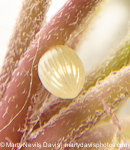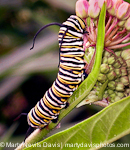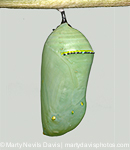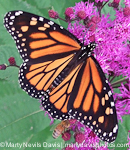monarch butterflies
four stages of metamorphosis
- EGG: the beginning of a monarch butterfly’s life is a tiny EGG, one of hundreds its mom will lay on milkweed. It looks like a tiny jewel, creamy-white with beautiful ridges and a pointed top. Visit my EGG page for more info.
- LARVA: the brief journey of a monarch LARVA or CATERPILLAR is only about two weeks long, but in that time it eats a lot of milkweed and increases in weight about 3,000 times. Visit my LARVA / CATERPILLAR page for more info.
- PUPA: the butterfly goes through the most remarkable changes in its third stage of metamorphosis. Known as a PUPA or CHRYSALIS, it becomes a butterfly in nine to eleven days. Visit my PUPA / CHRYSALIS page for more info.
- ADULT: a butterfly at last! After about a month from when its mom laid an egg on a milkweed plant, the adult BUTTERFLY emerges with small wet wings. In a few hours it will fly away. Visit my BUTTERFLY page for more info.
how to raise a monarch butterfly
It's easier than you might think, and with our monarch populations threatened, raising these amazing butterflies inside gives them a huge advantage for survival. You'll find lots of info about raising monarchs from Monarch Lab and Monarch Watch.
other butterflies!
Here's a great website to identify other butterflies and caterpillars which live in your area. Just enter your zip code. It includes the host and nectar plants needed to attract Monarchs, as well as all kinds of butterflies. Lots of good images! Gardens With Wings
Welcome to the wonderful world of Monarch butterflies! Thank you for stopping and I hope through my images you'll be able to learn more about these lovely creatures.
As a photographer who has raised thousands of monarchs over nearly three decades, I've been privileged to capture lots of images of their metamorphosis. As a "citizen scientist" and not an entomologist, my site features more images than detailed science. There are many fantastic websites you can visit for that info, including Monarch Watch, a site dedicated to monarch education, conservation, and research. Others are listed on my Resource Page.
The Monarch (Danaus plexippus), like all butterflies and moths, is a member of the order of insects called lepiodoptera, which includes approximately 160,000 species of butterflies and moths. The name Lepidoptera is derived from the Greek, meaning “scaly winged,” which refers to the many thousands of scales which cover their wings and body.
The life of the butterfly on the upper left began about a month earlier from how we see it here, having just emerged from its chrysalis within the hour of taking this photo. Its life began when its mom laid an egg on a milkweed plant, the only food a monarch larva can eat. The remarkable journey this monarch took - a complete metamorphosis - is both an honor and a mystery to witness.
On the left you can see below the four stages of complete metamorphosis: egg, larva / caterpillar, pupa / chrysalis, and the adult, which is what we call the butterfly.
The word metamorphosis literally means "change of body or change of form." Through my photos on the next few pages, I hope that you can clearly see what it means for this remarkable insect to be transformed from one creature into another. When a larva sheds its very last skin and becomes a chrysalis, it literally relinquishes everything it is to become something it has never been before.
In just a few weeks, a monarch will "morph" from a creepy-crawly caterpillar who can barely see and is bound to earth, into a butterfly with compound eyes who can see more colors of the rainbow than we can. It will be able to fly 30 mph to escape a predator and up to 100 miles a day when embarking on it's 2,000 to 3,000-mile journey to migrate to central Mexico where it will spend the winter high up in the mountains with millions of other monarchs.
Of all the butterflies in North America, it's the monarch butterfly which has captured the attention (and hearts) of millions, including mine, and hopefully yours as well.
FAQs
There are lots of great resources available from monarch experts! Check out some of these Frequently Asked Questions and butterfly facts from the Monarch Lab at the University of Minnesota. Or Ask An Expert your own question!






